What Is Biometrics?
Biometrics is defined as “Study of processes or means to uniquely recognize individual users (humans) based on one or more intrinsic physical or behavioral attributes or characteristics. Authentication devices that recognize prints, retinal patterns, or facial patterns are available. Depending on the level of security needed, organizations will commonly use a combination of these these types of authentication” (McGonigle & Mastrian, 558. 2018).
Based on our book the Biometrics is defined above. Basically it’s a form of authentication used to verify an individual user based on a characteristic.
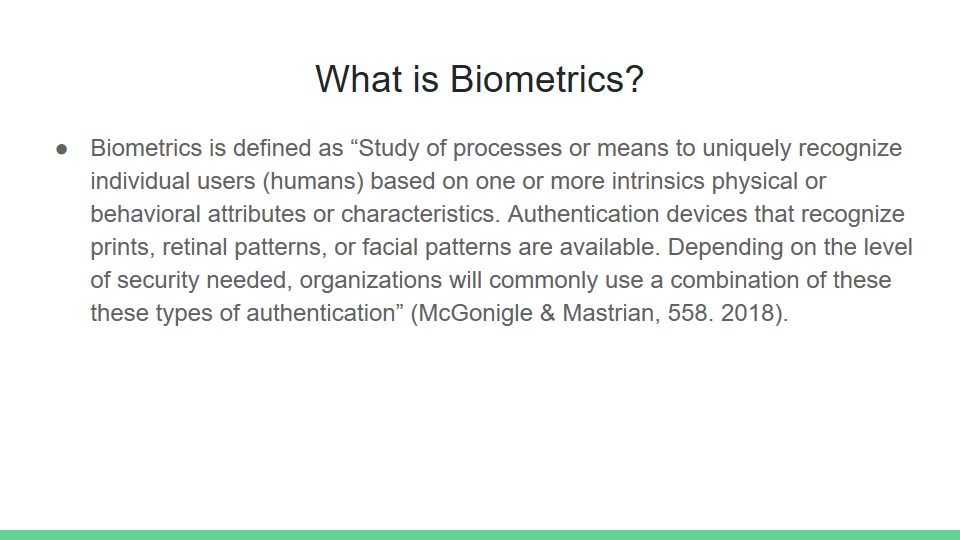
Purpose for Biometrics in Healthcare
- To provide a secure platform for patient information,
- To ensure appropriate access,
- To protect against inappropriate access,
- To simplify access in order to maximize time with the patient.
By providing a secure platform for patient information we as Nurses are complying with federal and HIPAA and HITECH guidelines. During one hospital stay many employees could view a patient’s record, by ensuring appropriate access we can protect the patient’s information. “ Since April 2009, in the US, Health Insurance Portability and Accountability Act (HIPAA) require physicians and healthcare professionals who use Electronic Health Record (EHR) track to be tracked every time a patient’s record is accessed.”
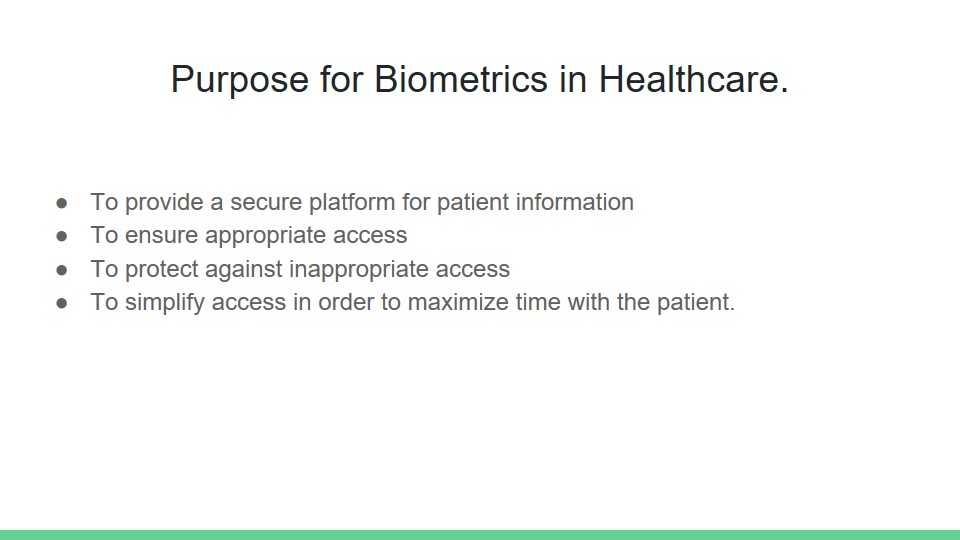
General Types of Biometrics
- Fingerprints.
- Retina scan.
- Voice, face, signature scan.
- Hand scan.
- Iris scan.
Biometric identification systems employ the use of biological data, in the forms provided above. Biometric identification cannot be forgotten or stolen. Each type of scan is unique to each person.
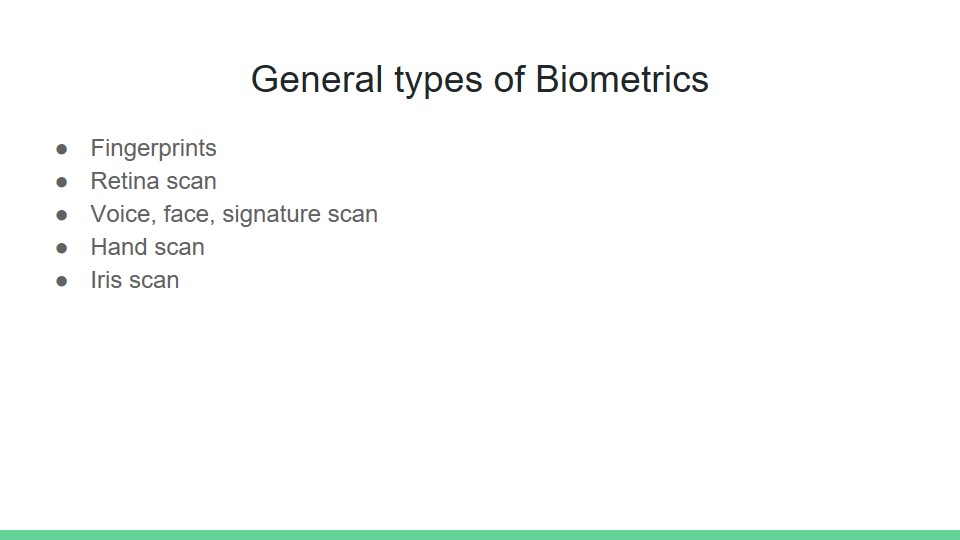
Use for Fingerprints in Healthcare
- In nursing fingerprint recognition is the main authentication used.
- Once you pass your nursing boards you are fingerprinted.
- Provides a high level of security.
The use of fingerprint recognition is very accurate and saves time. It is easy to use and can be accessed in many environments. As a nurse you are fingerprinted once you pass your state boards, that information is stored in a database. Once you get a job as an RN, and your place of employment uses fingerprint ID then you will be fingerprinted again so you have access to perform your job.
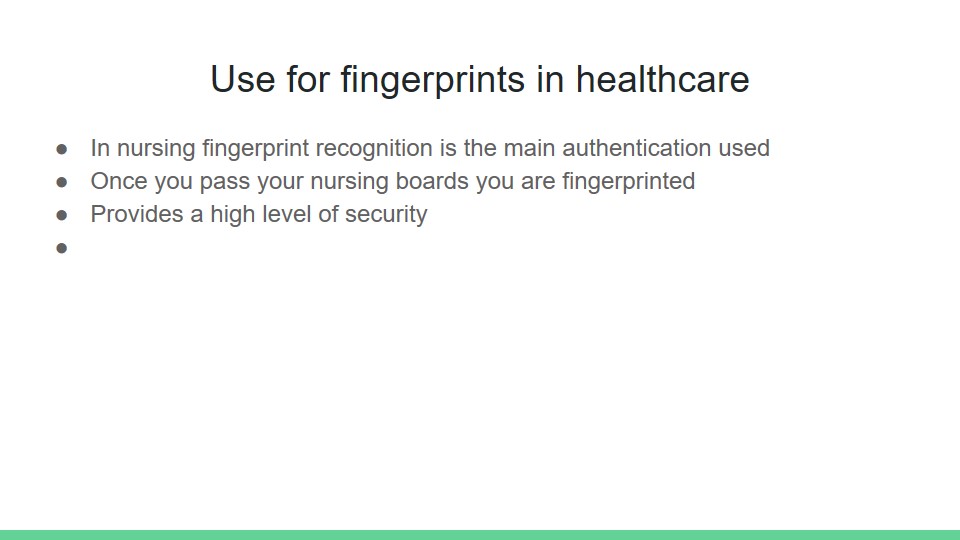
History and Current Use of the Technology in Healthcare
- General:
- Biometric technology was first used by law enforcement agencies.
- Fingerprints were used to link criminals to physical evidence of crimes.
- Biometrics have also been used to secure building access.
- Fun fact: facial recognition technology was used to identify and eject individuals charged with crimes and suspected terrorists out of the Super Bowl audience in 2001 (Woodward, 2001).
- In healthcare:
- HIPAA (1996) was enacted in order to prevent fraud and abuse, provide standards for information collected, and protect patient privacy and ensure the security of medical information (McGonigle & Mastrian, 2018).
- Health Information Technology for Economic and Clinical Health (HITECH) Act (2009) encourages agencies to move toward using electronic health records (McGonigle & Mastrian, 2018).
- Health care facilities begin to use biometrics to comply with the stringent privacy requirements laid out in HIPAA (Shawl, 2013).
- Current Uses (Chandra, Durand, & Weaver, 2008):
- Protect security of health records.
- Provide fast, secure access to medical information for patients and medical staff.
- Reduce the likelihood of data security threats.
- Mitigate health care/insurance fraud.
- Prevent medical errors.
- Ensure duplicate records are not created.
- Three Goals of Biometrics Technology Implementation:
- Provide a secure way for medical professionals to access Electronic Health Records:
- Example: the use of biometrics will ensure that only designated medical staff can see EHRs, which will mitigate HIPAA data breaches (Mogli, 2012).
- Improve efficiency in providing care:
- Example: nurses can quickly access health information by using a thumbprint rather than by entering a password into a computer (Shawl, 2013).
- Patient identification:
- Example: use to ensure that an individual signing in for chemotherapy treatment is the correct patient thereby preventing medical errors.
- Provide a secure way for medical professionals to access Electronic Health Records:
When we think of biometrics many people think of law enforcement immediately. This is because biometrics first began being used in law enforcement. Later on we saw it being used as security for homes, buildings, etc. -Kalynn.
HIPAA-Health insurance portability and accountability act of 1996 protects the privacy of patients. Biometrics plays a key role in protecting the privacy. The HITECH act encourages healthcare agencies to move toward electronic health records and charting. Healthcare facilities have slowly began using biometrics in healthcare and ensuring that patient information and documentation is safe. -Kalynn.
Some uses of biometric technology in healthcare includes: security to health records, ensures fast and secure access to medical records, mitigation of insurance fraud, prevention of medical errors by staff, and prevents duplicate records. -Kalynn.
A few important goals with biometrics in healthcare includes improving patient privacy with their medical records, quick nursing management using biometrics for charting, and patient identification. -Kalynn
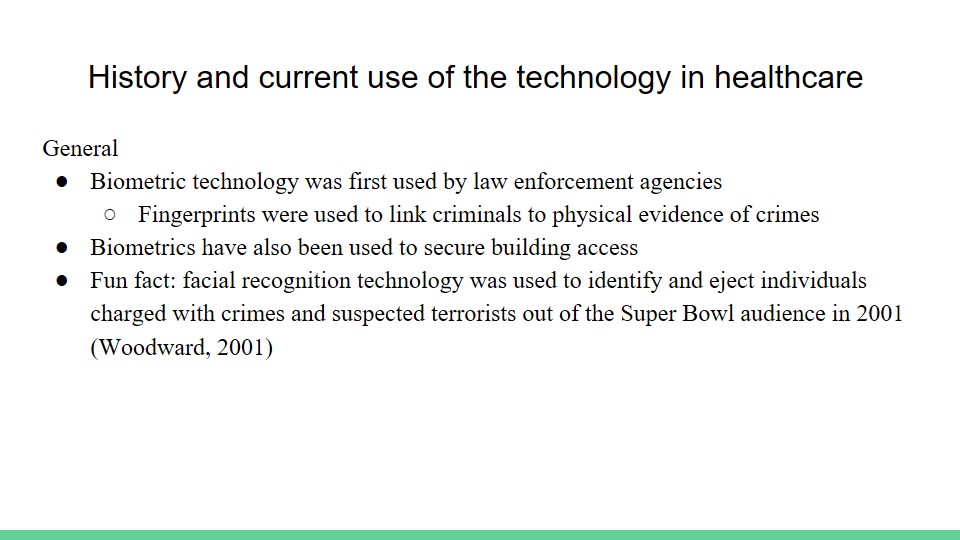
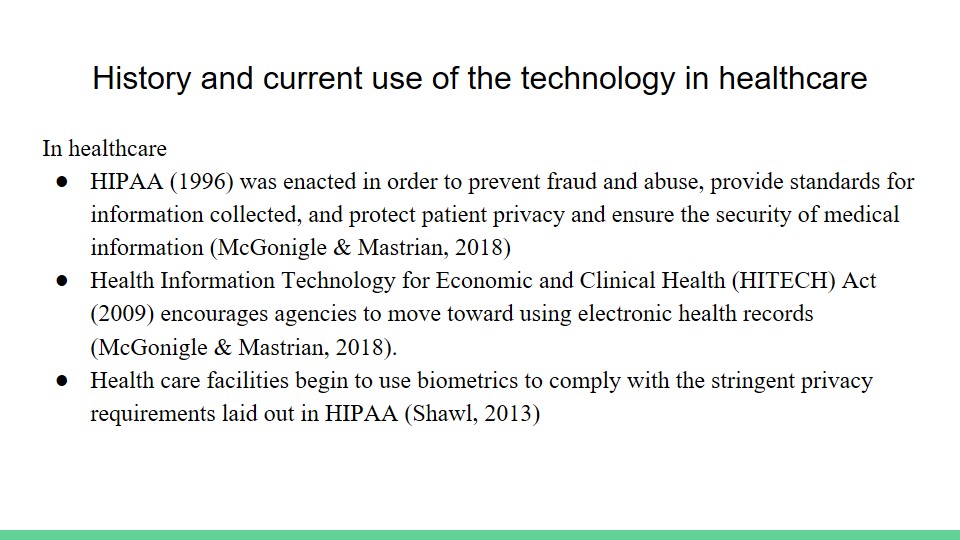
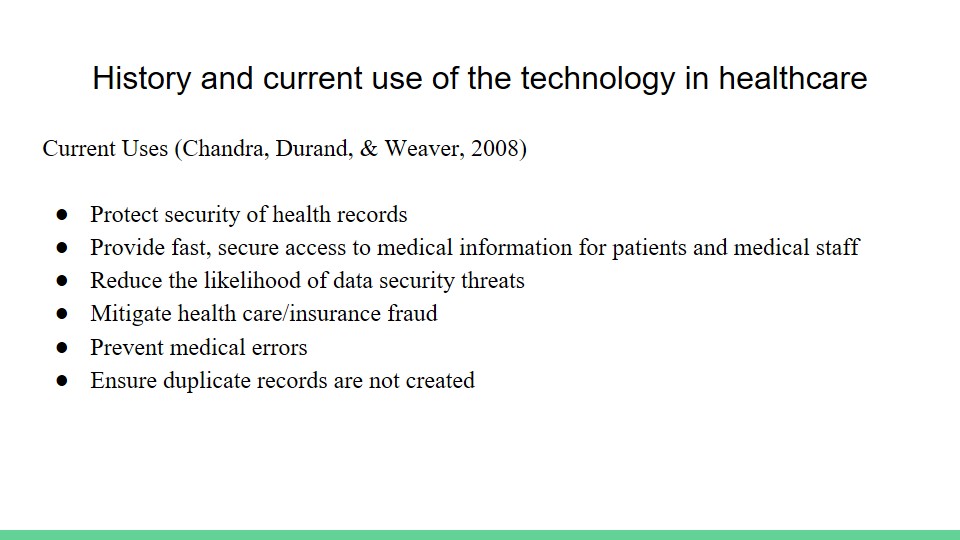
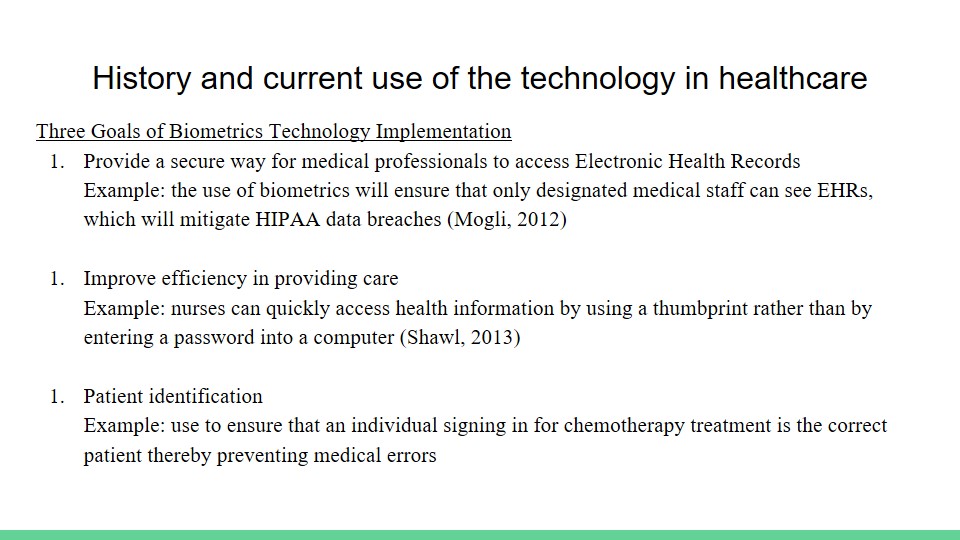
Impact on Healthcare and Nursing
- Easy check-in to clinics, emergency rooms, appointments. Electronic biometric check-in will decrease the amount of time that is used to admit patients.
- Facial recognition can decrease the amount of medications errors, charting errors, etc. Instead of seeing a name you will see a picture and a name.
- Three step identification: picture, name, DOB.
- Assurance that the patient is who they say they are.
- Easier to hold people financially responsible for their doctor’s appointments and emergency room visits.
Healthcare is being greatly impacted by biometrics use. It is such a simple task to walk in to a clinic and check in with your face on facial recognition. This leads to a decrease of errors on behlaf of the healthcare team. For example, it will be alot easier to identify a Maria Sanchez who is 63 years old vs. a Maria Sanchez who is 19 years old. This can offer 3 step identification(biometrics, verbal response, patient chart instead of 2 step. -Kalynn
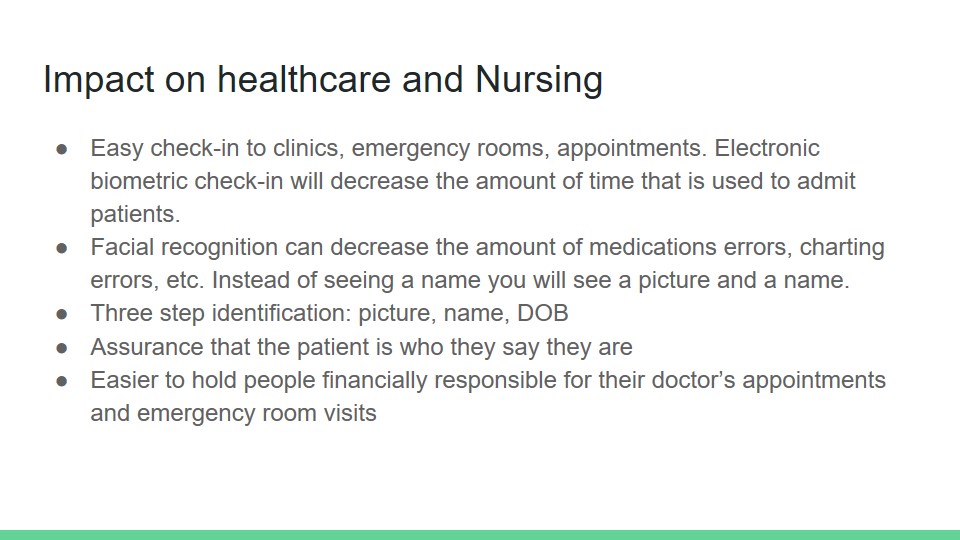
Patient Safety Impact
- Improved patient identification will lead to safe nursing management. This can lead to a decrease in errors.
- Reduces risk of fraud: biometrics taken at visits will make it safer for clinicians to give proper treatments and prevent misidentification.
- Different examples can include: face identification, fingerprinting, DNA.
- According to Imprivata, “Hunterdon Healthcare felt that the number of duplicate and inaccurate medical records in their system was just too much, adding up to about 13-14% of their patients’ on an annual basis. With biometrics, they were able to get that number down and better treat their patients with accurate care” (Imprivata, 2016).
Speaker notes: patient safety will be greatly impacted by the change of client documentation and presentation. This is why biometrics is really being pushed in healthcare. First and foremost, patient ID is the most obvious safety issue. Also, this goes along with reducing the amount of fraud that is being committed. We have a statistics here from Imprivata that shows with statistics that biometrics led to appropriate use of healthcare medical records. -kalynn.
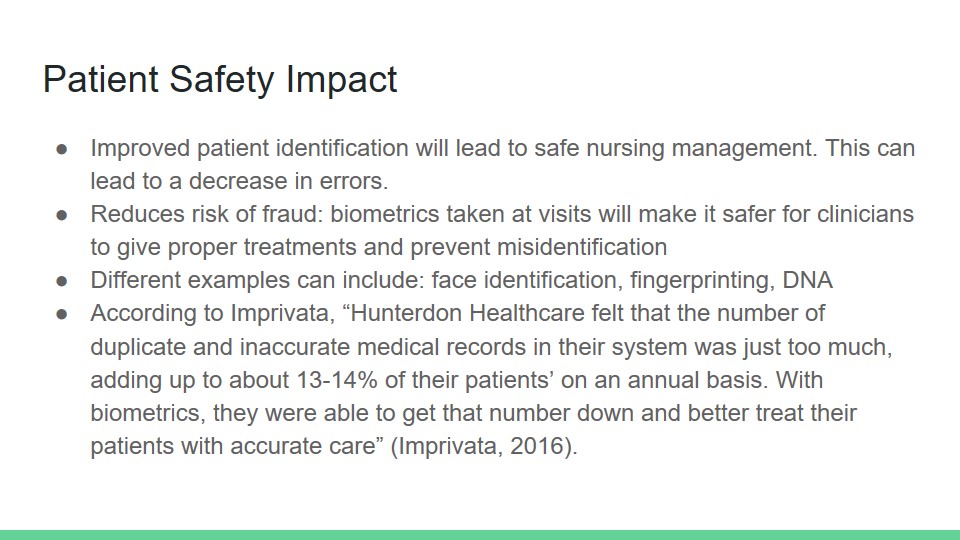
Advantages
- Protects patient privacy: biometrics decreases the risk of fraud in healthcare. This also includes financial fraud and insurance fraud.
- Quick admission checkpoints with the use of biometrics plus the other identification factors that each hospital uses.
- Easy way to differentiate between patients medical records. Facial recognition can be used for this method.
- Reduces chance of malpractice.
Some advantages include: protection of privacy and reducing amount of fraud. This can also prevent somebody from using a family members insurance to go receive healthcare for themselves. Admission to healthcare areas are quick, easy, and accurate because of biometrics. Lessens the chance of nurse error by allowing facial recognition to show a picture of the patient on their chart. Overall, biometrics in healthcare will significantly reduce the chance of malpractice among clinics and hospitals. It is a very direct, obvious way to differentiate within your patients. -Kalynn
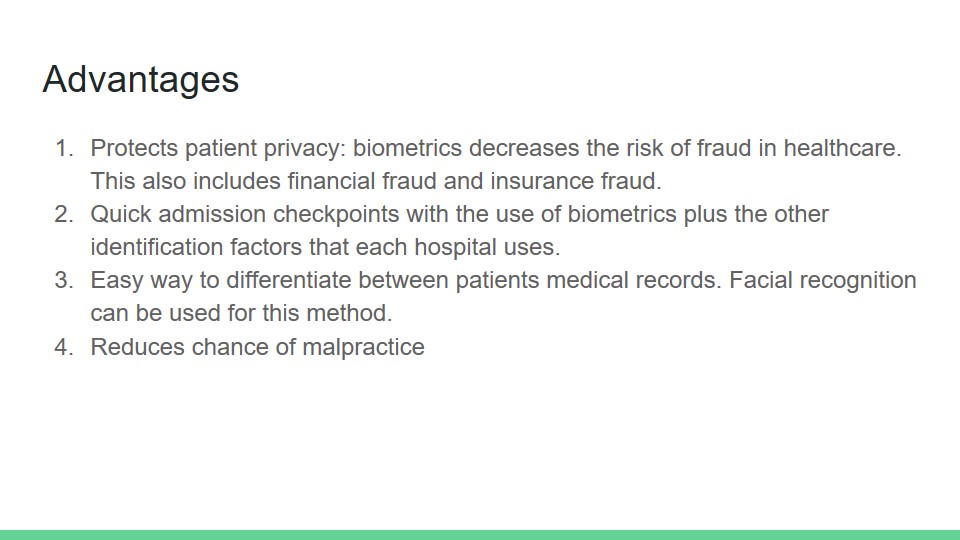
Disadvantages
- High upfront cost: to begin the installation of the biometric system the initial cost could be very high. Many hospitals and clinics do not have the means to pay the amount upfront.
- New technology for patients and clinicians can be stressful and very difficult. Initially there may need to be a team to come and train the staff on the new technology.
- People with criminal records may not want to seek care due to the risk of being found by the police because their biometrics were used.
- This may decrease the amount of jobs needed in the hospital or clinic check-in area.
Although biometrics in healthcare seems so easy, it does have its disadvantages. One of them is the cost that it would bring to a hospital or clinic. Eventually it will pay for itself since there would need to be less staff. However, the upfront cost for the equipment, training, and programming may be very high. Also, many employees and even patients may feel frustration towards the new technology. Furthermore, people who have significant criminal records or immigrants may feel scared to go receive healthcare due to being caught by law enforcement. Finally, this may actual make people lose their jobs due to the amount of technology that is taking over. -Kalynn.
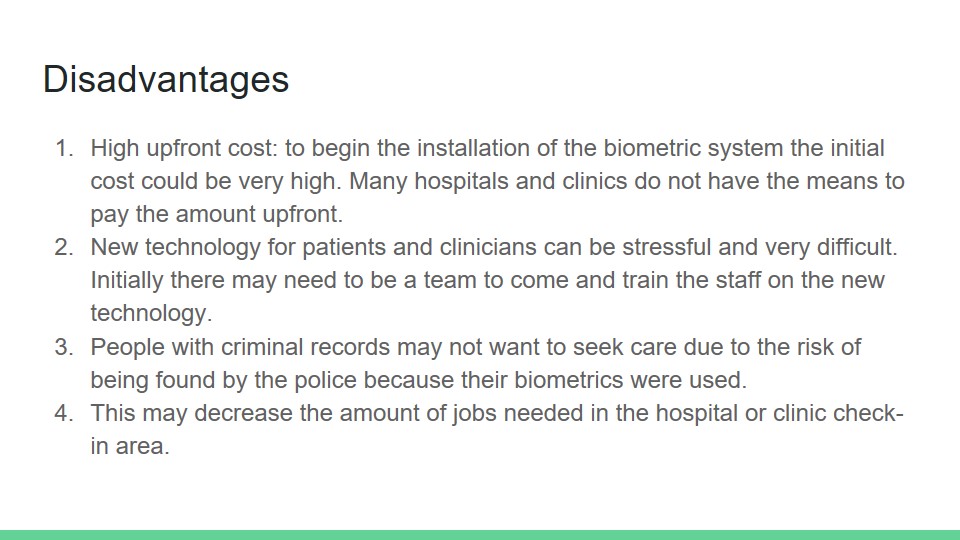
Impact on Professional Nursing Practice
Biometrics being used in healthcare will impact nursing practice because it will allow easier access to charting. Nurses themselves can even use biometrics to access their patients information. For example, a nurse can use her fingerprints to login to the charting system.
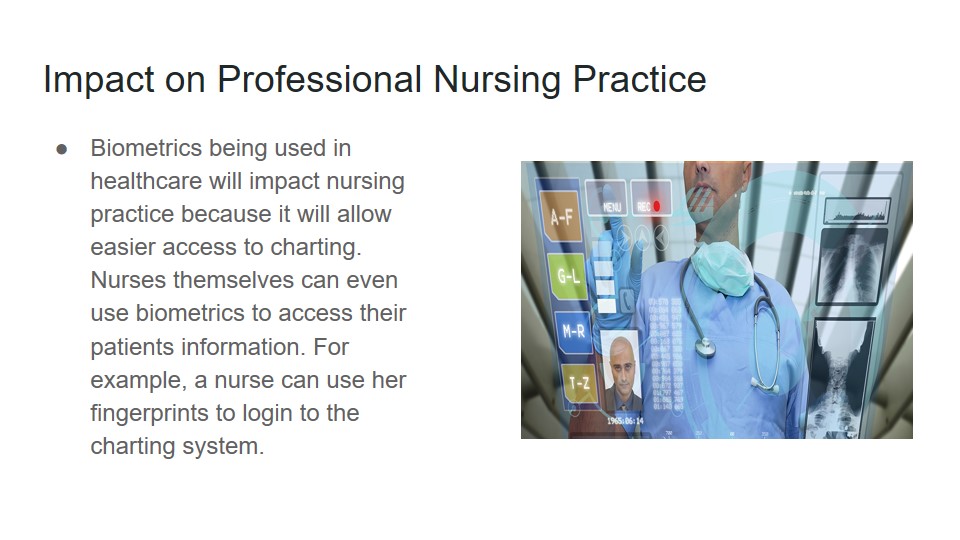
Patient Safety Impact Within the Healthcare System
- Verify that patients are who they say they are.
- Guarantee caregivers are working with the proper medical and demographic information.
- Ensure only the proper employees have access to the right information.
Biometrics has a huge impact on safety within the healthcare system. It’s used to verify that patients are who they say they are, guarantee caregivers are working with the proper medical and demographic information, and ensure only the proper employees have access to the right information.
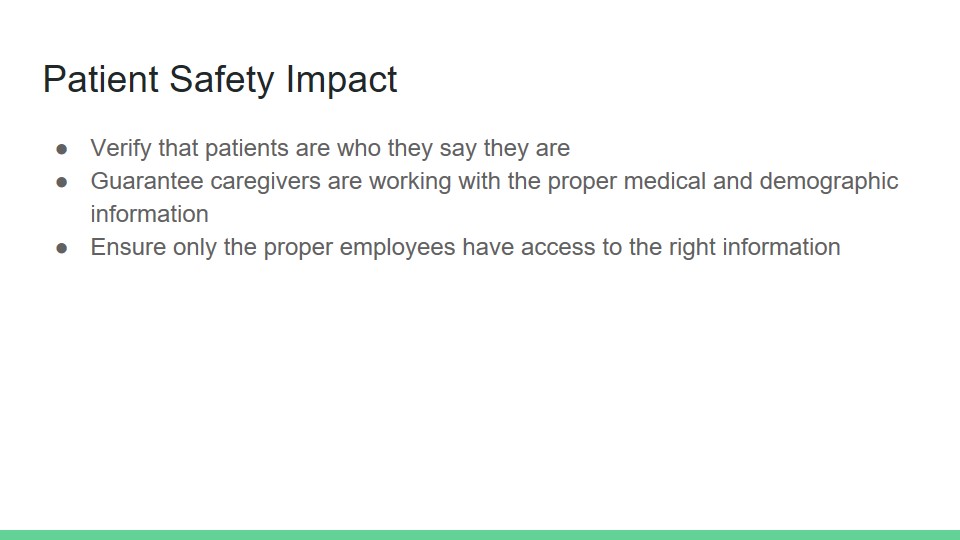
Impact on Patient Care and Delivery, Quality Care Measures/Monitoring, and Risk Management
- Potential positive outcomes for patient care (Chandra et al., 2008; Martinez-Martin, 2019; Mogli, 2012):
- assistance in diagnosing, monitoring, risk detection and management (e.g., facial recognition);
- quality improvement: reduction in errors.
- Implications to be considered:
- ethical and legal considerations;
- infrastructure/operational consequences; impact on a population.
As it was mentioned, biometrics could have significant implications for patient care. Indeed, research indicates that biometrics-based technologies do not just protect privacy but can also be applied to diagnosing. For instance, facial recognition patterns can be used to find signs of genetic disorders and monitor health predictors (Martinez-Martin, 2019; Mogli, 2012). In addition, the technology’s ability to reduce errors can directly improve care quality (Chandra et al., 2008). However, patient care is also interconnected with multiple other factors, including infrastructure, ethics, and legal concerns, and the impact of biometrics use on them needs to be considered as well.
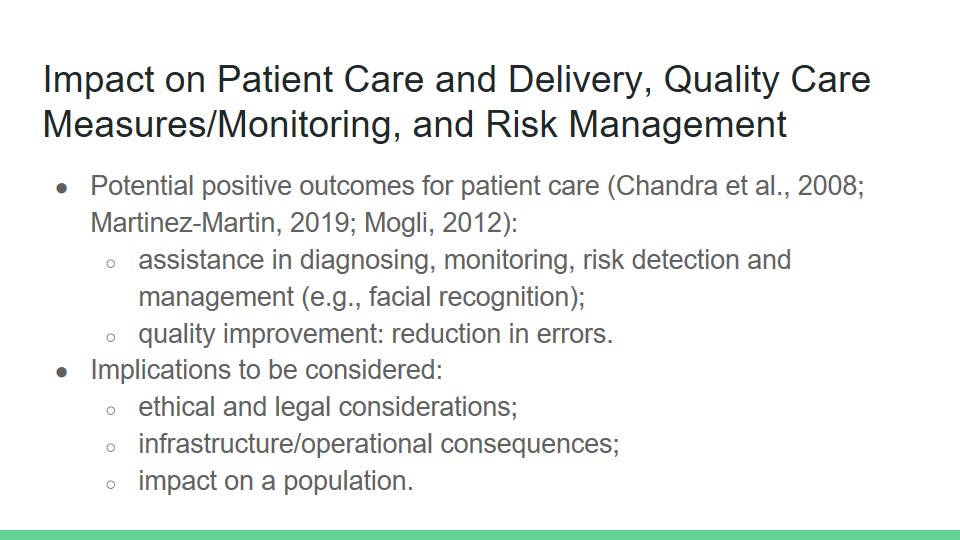
Ethical and Legal Considerations
- Key concerns (Chandra et al., 2008; Martinez-Martin, 2019):
- privacy (due to collecting personal information);
- consent;
- technology characteristics (accuracy);
- Relevant solutions:
- appropriate legislation/policies (informed consent, privacy) (Martinez-Martin, 2019);
- education (for healthcare providers) (Chandra et al., 2008);
- sufficient information (for patients) (Martinez-Martin, 2019).
First, biometrics are connected to ethical and legal issues predominantly because biometrics-based technologies work with personal information. The leaking of such data would constitute major problems, which is why biometrics use is associated with privacy dangers. Furthermore, the consent of the people who provide personal data also needs to be ensured for an ethical application of biometrics. In addition, concerns have been raised with regard to errors and failures that any technology is not safe from (Martinez-Martin, 2019). Given the type of data that biometrics technologies usually focus on, potential negative outcomes could be rather severe, for example, if an individual is mistaken for a criminal. Thus, to ensure patient safety and high quality of care, all the mentioned concerns need to be mitigated through legislation, suitable policies, and education.
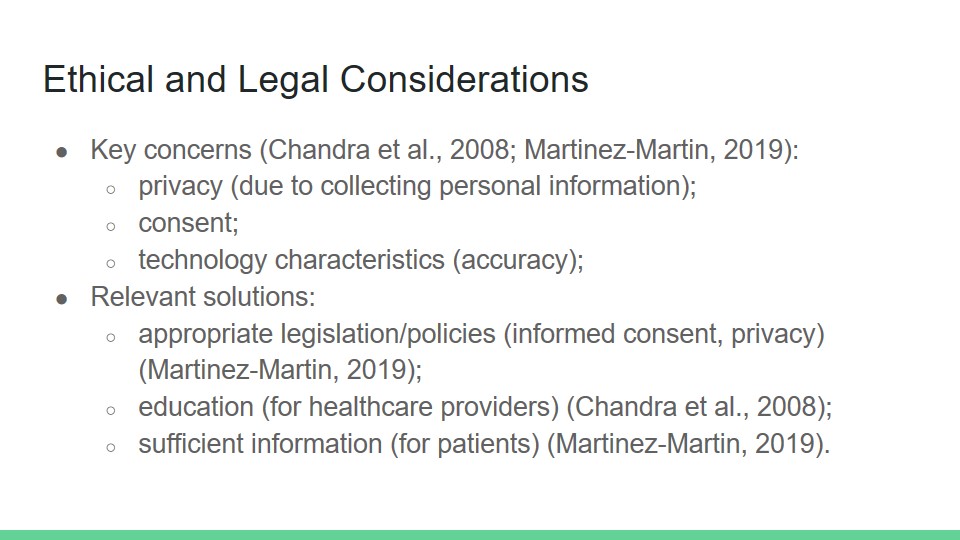
Infrastructure/Operational Consequences
- Major concerns (Chandra et al., 2008; Martinez-Martin, 2019; Odei-Lartey et al., 2016):
- lack of infrastructure/equipment;
- associated costs;
- required training;
- lack of relevant procedures/policies.
- Resolution of the issues is required for patient safety and quality of care.
Another factor that is very important for high-quality care includes infrastructure-related and operational concerns. Indeed, since biometrics could be considered a relatively new phenomenon for healthcare, researchers find that many healthcare institutions lack the infrastructure, equipment, and qualified staff that would enable the use of innovative technologies (Chandra et al., 2008; Martinez-Martin, 2019; Odei-Lartey et al., 2016). An organization that does not have relevant policies and infrastructure would not be able to enjoy the benefits of using biometrics, which is why the introduction of biometrics-based technology can be a very costly activity.
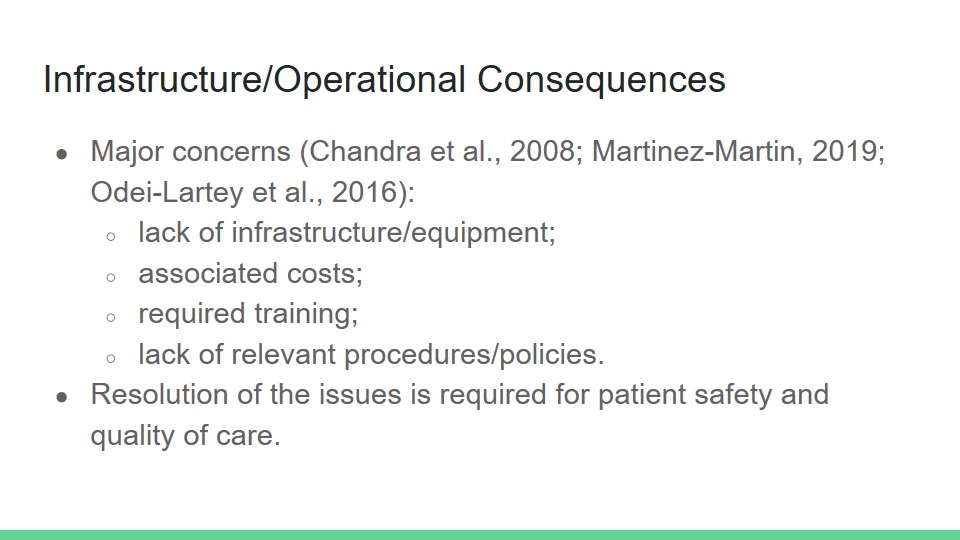
Impact on a Population
- Most populations (Martinez-Martin, 2019; Woodward, 2001):
- can enjoy the benefits (better diagnosing, safety, privacy, reduced mistakes, etc.);
- might be reluctant to use the technologies (increased surveillance; can be resolved through education).
- Certain populations (Chandra et al., 2008):
- may drive away people who are concerned about surveillance;
- people engaged in criminal activity are especially at risk.
Finally, patients should also be mentioned. Mostly, patients can enjoy the advantages of the use of biometrics as long as their cooperation is ensured with the help of informed consent (Martinez-Martin, 2019; Woodward, 2001). However, it cannot be ignored that certain populations might be turned away from healthcare organizations that use biometrics, for example, because they are too uncomfortable with the idea or because their feel like it would be a risk.
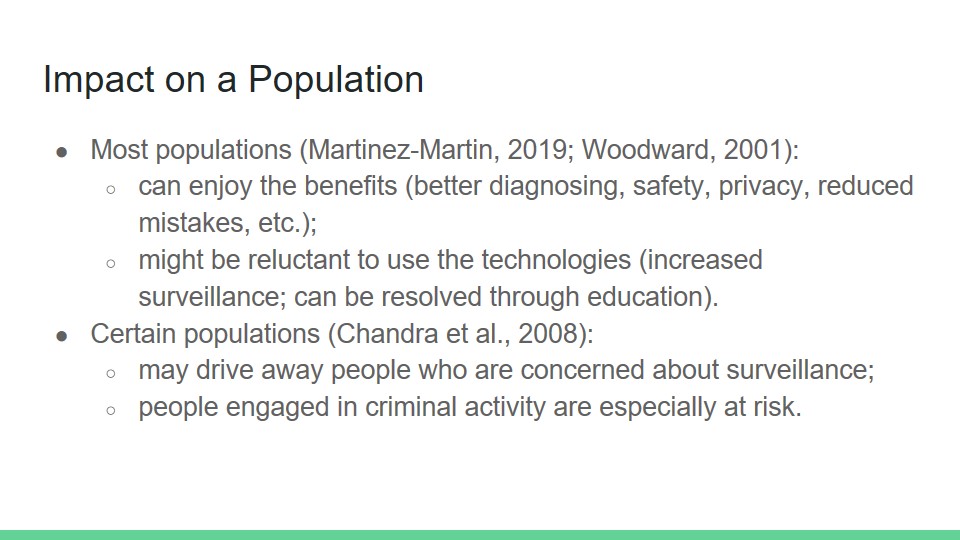
Examples
- Fingerprint identification to monitor attendance; Odei-Lartey et al. (2016) showed that it is feasible but has limitations (effectiveness: 65%), requires costly equipment, and may theoretically be rejected by patients.
- Northwell Health in New Hyde Park, NY: uses iris scanning; has benefits but requires equipment and is associated with greater surveillance.
All these factors interact and affect the ability of biometrics to improve care. For example, a study by Odei-Lartey et al. (2016) demonstrated that fingerprint identification could be used to monitor patient attendance and generally assist with the processing of healthcare data. The authors reported that additional identification techniques might be required since the fingerprint-based technology which they were testing was about 65% effective, which shows that technical limitations might be a barrier. Furthermore, Odei-Lartey et al. (2016) noted that the equipment for their proposed identification system was not cheap, and while they reported that their participants did not find the idea of using biometrics problematic, the authors considered the possibility of people refusing to participate. Other examples of the use of biometrics in healthcare can be analyzed in similar ways.
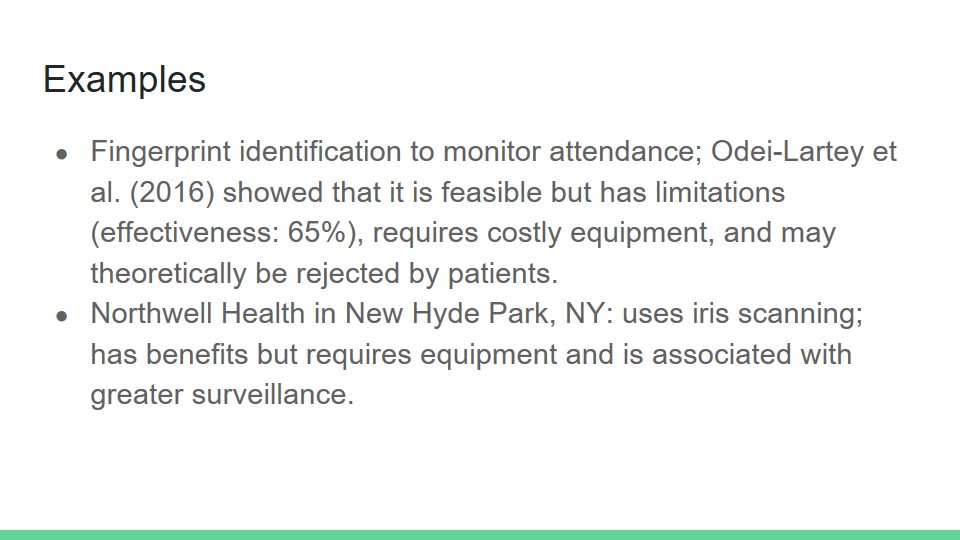
Controversy, Issues, Challenges, and Regulatory Implications
- Privacy: surveillance, errors, individual concerns (Chandra et al., 2008).
- Informed consent: lack of information; requires relevant procedures and could use legislation (Martinez-Martin, 2019).
- Overreliance on technology (errors remain a problem).
- Examples: 65% – the effectiveness of a fingerprint identification method; 85% – the effectiveness of several identification methods combined (Odei-Lartey et al., 2016).
As follows from these examples, there are significant concerns that are associated with the use of biometrics. From the perspective of privacy, issues like errors, surveillance concerns, and individual resistance are significant. From the perspective of informed consent, it is noteworthy that a lot of patients have little understanding of biometrics, and it is necessary to provide all the relevant information about benefits and risks to them (Martinez-Martin, 2019). If an institution does not have relevant policies or does not emphasize lawful informed consent practices, the problem becomes even more significant. In addition, since the technologies are fallible, overreliance of them needs to be avoided.

Solutions
- Appropriate legislation to protect privacy (e.g., HIPAA) (Martinez-Martin, 2019).
- Legislation to ensure informed consent.
- Improvement/combination of technology to reduce errors (Odei-Lartey et al., 2016).
- Education and awareness improvement (Martinez-Martin, 2019).
However, all the mentioned issues can be resolved. Legislation, including the laws and acts that already exist (for instance, HIPAA), is a primary solution to the problems of privacy or informed consent. As an alternative, organization-level policies might be introduced as well to ensure the ethical and lawful application of biometrics (Martinez-Martin, 2019). The problem of technological errors is resolved by testing and improving technology and using several options when it is feasible, for instance, in the case of an identification system proposed by Odei-Lartey et al. (2016). Finally, education is a major tool that can help to improve patients’ ability to consent to the use of biometrics and specialists’ ability to apply them.
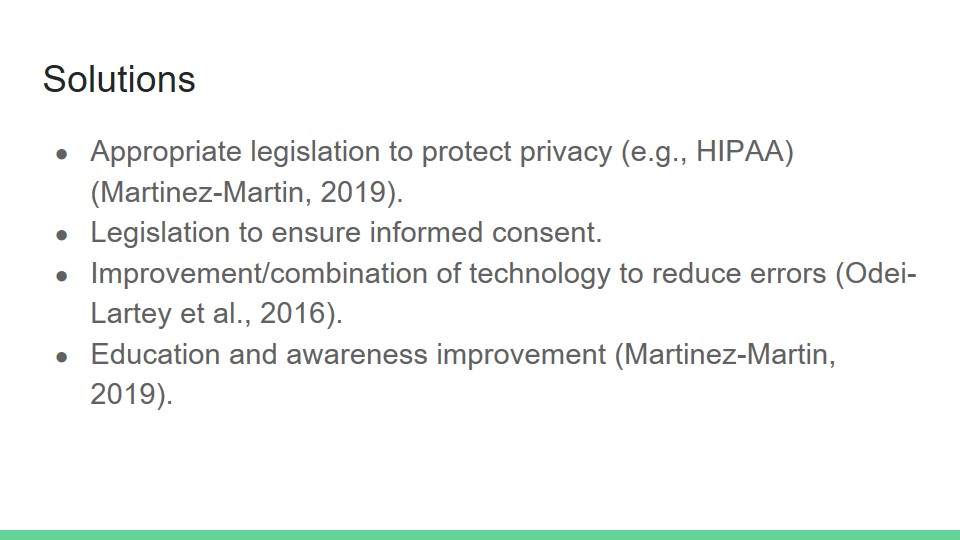
Summary
- Biometrics can be introduced for safety/privacy reasons; have significant potential for improving patient care.
- Disadvantages: costs, training, consequences for some patients and employees.
- A surprise: potential for error reduction.
- Lesson learned: the importance of appropriate regulations and education.
In summary, biometrics can be among the tools that healthcare may borrow from other fields to improve safety, privacy, and quality of care. A surprising fact that biometrics might even reduce error rates, which is very important in healthcare settings. This tool comes with significant concerns and even disadvantages, and they need to be taken into account when introducing it. However, as long as healthcare professionals push for education and research on the topic, as well as relevant regulations and legislation, biometrics might become a major asset.
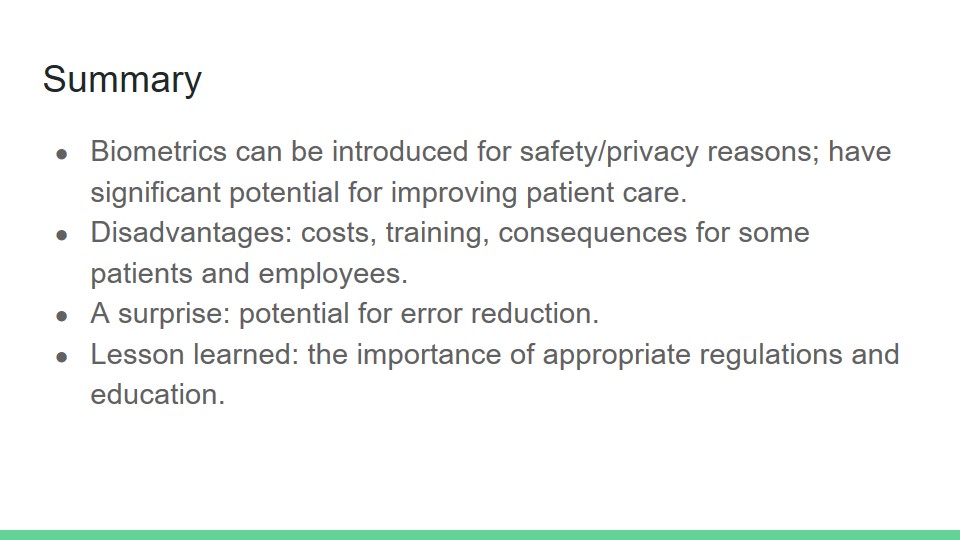
References
Chandra, A., Durand, R., & Weaver, S. (2008). The uses and potential of biometrics in health care: Are consumers and providers ready for it? International Journal of Pharmaceutical and Healthcare Marketing, 2(1), 22-34. Web.
Martinez-Martin, N. (2019). What are important ethical implications of using facial recognition technology in health care? AMA Journal of Ethics, 21(2), E180-187. Web.
Mogli, G. (2012). Role of Biometrics in healthcare privacy and security management system. Sri Lanka Journal of Bio-Medical Informatics, 2(4). Web.
Odei-Lartey, E. O., Boateng, D., Danso, S., Kwarteng, A., Abokyi, L., Amenga-Etego, S., … Owusu-Agyei, S. (2016). The application of a biometric identification technique for linking community and hospital data in rural Ghana. Global Health Action, 9(1), 1-7. Web.
Shawl, D. (2013). Biometrics—implementing into the healthcare industry increases the security For the doctors, nurses, and patients (Doctoral dissertation, Thesis for Masters Degree Information Assurance).
Woodward Jr, J. D. (2001). Super Bowl surveillance: Facing up to biometrics. Santa Monica, CA: Rand Arroyo Center.